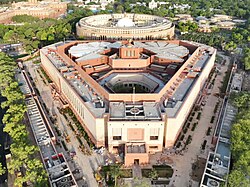New Delhi
New Delhi
नई दिल्ली | |
|---|---|
Federal capital | |
| Motto(s): Śrama ēva jayatē Labour is victory | |
| Coordinates: 28°36′50″N 77°12′32″E / 28.61389°N 77.20889°E | |
| Country | |
| Union territory | |
| Lok Sabha constituency | New Delhi |
| Legislative Assembly | New Delhi |
| District | New Delhi |
| Established | 12 December 1911 |
| Inaugurated | 13 February 1931 |
| Founded by | George V |
| Government | |
| • Type | Municipal Council |
| • Body | New Delhi Municipal Council |
| • Chairman | Amit Yadav, IAS |
| Area | |
| • Capital city | 42.7 km2 (16.49 sq mi) |
| • Rank | 10 |
| Elevation | 216 m (708.62 ft) |
| Population (2011)[3] | |
| • Capital city | 249,998 |
| • Rank | 11 |
| • Density | 5,900/km2 (15,000/sq mi) |
| • Metro (2018; includes entire urban Delhi + part of NCR) | 28,514,000 |
| Time zone | UTC+05:30 (IST) |
| PIN | 110001, 121003, 1220xx, 201313 (New Delhi) |
| Area code | +91-11 |
| Vehicle registration | DL-2X |
| International Airport | Indira Gandhi International Airport |
| Website | www |

New Delhi (Hindi: नई दिल्ली, romanized: Naī Dillī) is the capital of India. It is also a part of the National Capital Territory of Delhi (NCT).
In traditional Indian geography, it is in the North Indian zone. The city has an area of about 42.7 square kilometres (16.5 sq mi). New Delhi has a population of about 9.4 million people.[5]
Delhi and New Delhi are often used as if they mean the same thing, but they are actually different. New Delhi is a small part of the larger city of Delhi, and it is also the seat of the Indian government. The National Capital Territory (NCT) of Delhi includes New Delhi and other surrounding areas. Beyond this is the National Capital Region (NCR), which is even bigger. It includes nearby cities like Ghaziabad, Noida, Greater Noida, Meerut, YEIDA City, Gurgaon, and Faridabad, forming a large connected urban area.
New Delhi was planned and built during British rule. Its foundation stone was laid in 1911 by King George V at the Delhi Durbar. British architects Edwin Lutyens and Herbert Baker designed the city. New Delhi officially became the capital on 13 February 1931, when it was inaugurated by the then Viceroy, Lord Irwin.[6][7]
Demographics
[change | change source]As of 2011, the New Delhi Municipal Council area has a population of 249,998.[3] Hindi is the most widely spoken language in New Delhi and the lingua franca of the city. English is primarily used as the formal language by business and government institutes.[8] New Delhi has a literacy rate of 89.38% according to 2011 census, which is the highest in Delhi.[9]
Religion
[change | change source]According to 2011 census, Hinduism is the religion of 89.8% of New Delhi's population.[10] There are also communities of Muslims (4.5%), Christians (2.9%), Sikhs (2.0%), Jains (0.4%).[10] Other religious groups include Parsis, Buddhists, and Jews.[11]
Government
[change | change source]The national capital of India, New Delhi is jointly administered by both the Central Government of India and the local Government of Delhi, it is also the capital of the National Capital Territory (NCT) of Delhi.


New Delhi is administered through a municipal government, known as the New Delhi Municipal Council (NDMC). The other urban areas of the metropolis of Delhi are administered by the Municipal Corporation of Delhi and Delhi Cantonment Board. As of 2015[update], the government structure of the New Delhi Municipal Council includes a chairperson, three members of New Delhi's Legislative Assembly, two members nominated by the Chief Minister of the NCT of Delhi and five members nominated by the central government.
The districts of the NCT were redrawn in 2012 and include a district called New Delhi, albeit with different borders than the municipality. The New Delhi district includes not only the area of the municipality of the same name but also encompasses the Delhi Cantonment and parts of the Municipal Corporation of Delhi area.
References
[change | change source]- ↑ "About Delhi". Archived from the original on 12 June 2021. Retrieved 26 November 2020.
- ↑ Amanda Briney. "Geographic Facts About New Delhi, India". ThoughtCo.com Education. Archived from the original on 28 April 2021. Retrieved 28 April 2021.
- ↑ 3.0 3.1 "Provisional Population Totals. Cities having population 1 lakh and above" (PDF). Census of India 2011. Archived from the original on 26 December 2018. Retrieved 12 December 2021.
- ↑ "The World's Cities in 2018" (PDF). United Nations. Archived (PDF) from the original on 31 August 2021. Retrieved 2 September 2021.
- ↑ "Facts about New Delhi". New Delhi Hub. Archived from the original on 2018-08-15. Retrieved 17 October 2009.
- ↑ Lahiri, Tripti (13 January 2012). "New Delhi: One of history's best-kept secrets". The Wall Street Journal.
- ↑ Stancati, Margherita (8 December 2011). "New Delhi becomes the capital of Independent India". The Wall Street Journal. Retrieved 12 December 2023.
- ↑ "Know about Delhi Fast Facts, Area, population, Geographical Location, Languages". 6 July 2019. Archived from the original on 26 September 2021. Retrieved 8 February 2020.
- ↑ "Provisional Population Totals, Census of India 2011; Cities having population 1 lakh and above" (PDF). Office of the Registrar General & Census Commissioner, India. Archived (PDF) from the original on 9 October 2022. Retrieved 26 March 2012.
- ↑ 10.0 10.1 10.2 "Religion PCA". censusindia.gov.in. Government of India. Archived from the original on 7 July 2016. Retrieved 8 July 2016. In the downloaded Excel file, scroll down to row number 56 which mentions religious data for NDMC.
- ↑ "Data on Religion". Census of India 2001. 2001. p. 1. Archived from the original on 14 May 2007. Retrieved 16 May 2006.












